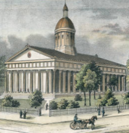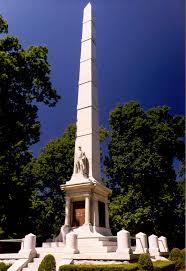
1849   James Whitcomb Riley was born in Greenfield. Beginning as an itinerant sign painter and musician, he became the “Hoosier Poet” and one of the most famous people of his time. His poems, like “When the Frost is on the Punkin'” and “Little Orphant Annie,” captured the childhood memories of an entire generation and appealed to people of all ages.
|

1850   Indiana’s Second Constitutional Convention convened in Indianapolis. The 150 delegates addressed issues that had arisen during the formative years of the state. Population growth since statehood in 1816, combined with radical changes in the economy, had brought about a need to form a more modern document. The convention concluded its work in 127 days. The 1851 Constitution, with amendments, continues to serve as the foundation of state government. Pictured: The Indiana Statehouse in 1850.
|
 1886   Speculators discovered natural gas in a cornfield near Kokomo, leading to a “gas boom.” The plentiful supply of nearly-free fuel led to the establishment of many glass manufacturing companies in the area. Many jobs were created in a short time. The population of Kokomo doubled from about 4,000 to over 8,000 in the next few years. 1886   Speculators discovered natural gas in a cornfield near Kokomo, leading to a “gas boom.” The plentiful supply of nearly-free fuel led to the establishment of many glass manufacturing companies in the area. Many jobs were created in a short time. The population of Kokomo doubled from about 4,000 to over 8,000 in the next few years. |
 1912   Woodrow Wilson, Governor of New Jersey, made a late-night visit to the Indiana Statehouse. He went into the rotunda to see a model home exhibit. There he was treated to coffee and homemade biscuits by students from Manual Training High School. He also viewed exhibits on other floors of the Capitol, including the chamber of the House of Representatives where he witnessed demonstrations of equipment used in coal mine rescues. He was in the city campaigning for President of the United States. 1912   Woodrow Wilson, Governor of New Jersey, made a late-night visit to the Indiana Statehouse. He went into the rotunda to see a model home exhibit. There he was treated to coffee and homemade biscuits by students from Manual Training High School. He also viewed exhibits on other floors of the Capitol, including the chamber of the House of Representatives where he witnessed demonstrations of equipment used in coal mine rescues. He was in the city campaigning for President of the United States. |
 1946   Ernest M. Viquesney died in Spencer, Indiana. A talented artist, he became best known as a sculptor. His most famous work is a statue titled “The Spirit of the American Doughboy,” which depicts a World War I soldier in full battle uniform. One of the most popular statues in American history, it was mass produced and at one time was found at over 300 locations across the country, most often in parks and county courtyards. It is still standing in 11 Indiana cities, including Evansville, Attica, New Castle, Muncie, Peru, and the sculptor’s hometown of Spencer. Pictured: “The Spirit of the American Doughboy” in front of the Owen County Courthouse in Spencer. 1946   Ernest M. Viquesney died in Spencer, Indiana. A talented artist, he became best known as a sculptor. His most famous work is a statue titled “The Spirit of the American Doughboy,” which depicts a World War I soldier in full battle uniform. One of the most popular statues in American history, it was mass produced and at one time was found at over 300 locations across the country, most often in parks and county courtyards. It is still standing in 11 Indiana cities, including Evansville, Attica, New Castle, Muncie, Peru, and the sculptor’s hometown of Spencer. Pictured: “The Spirit of the American Doughboy” in front of the Owen County Courthouse in Spencer. |
 1960   The Tippecanoe Battlefield was designated a National Historic Landmark. An 85-foot marble obelisk stands on the site where the Battle of Tippecanoe was fought in 1811. United States forces, led by William Henry Harrison, clashed with the Native American federation led by Shawnee Chief Tecumseh. The area now encompasses 96 acres and includes picnic areas, a nature center, and hiking trails. 1960   The Tippecanoe Battlefield was designated a National Historic Landmark. An 85-foot marble obelisk stands on the site where the Battle of Tippecanoe was fought in 1811. United States forces, led by William Henry Harrison, clashed with the Native American federation led by Shawnee Chief Tecumseh. The area now encompasses 96 acres and includes picnic areas, a nature center, and hiking trails. |
Follow this link to subscribe to Hoosier History Highlights and to view archived editions
Follow us on Instagram: @instatehousetouroffice
|





 1886   Speculators discovered natural gas in a cornfield near Kokomo, leading to a “gas boom.” The plentiful supply of nearly-free fuel led to the establishment of many glass manufacturing companies in the area. Many jobs were created in a short time. The population of Kokomo doubled from about 4,000 to over 8,000 in the next few years.
1886   Speculators discovered natural gas in a cornfield near Kokomo, leading to a “gas boom.” The plentiful supply of nearly-free fuel led to the establishment of many glass manufacturing companies in the area. Many jobs were created in a short time. The population of Kokomo doubled from about 4,000 to over 8,000 in the next few years. 1912   Woodrow Wilson, Governor of New Jersey, made a late-night visit to the Indiana Statehouse. He went into the rotunda to see a model home exhibit. There he was treated to coffee and homemade biscuits by students from Manual Training High School. He also viewed exhibits on other floors of the Capitol, including the chamber of the House of Representatives where he witnessed demonstrations of equipment used in coal mine rescues. He was in the city campaigning for President of the United States.
1912   Woodrow Wilson, Governor of New Jersey, made a late-night visit to the Indiana Statehouse. He went into the rotunda to see a model home exhibit. There he was treated to coffee and homemade biscuits by students from Manual Training High School. He also viewed exhibits on other floors of the Capitol, including the chamber of the House of Representatives where he witnessed demonstrations of equipment used in coal mine rescues. He was in the city campaigning for President of the United States. 1946   Ernest M. Viquesney died in Spencer, Indiana. A talented artist, he became best known as a sculptor. His most famous work is a statue titled “The Spirit of the American Doughboy,” which depicts a World War I soldier in full battle uniform. One of the most popular statues in American history, it was mass produced and at one time was found at over 300 locations across the country, most often in parks and county courtyards. It is still standing in 11 Indiana cities, including Evansville, Attica, New Castle, Muncie, Peru, and the sculptor’s hometown of Spencer. Pictured: “The Spirit of the American Doughboy” in front of the Owen County Courthouse in Spencer.
1946   Ernest M. Viquesney died in Spencer, Indiana. A talented artist, he became best known as a sculptor. His most famous work is a statue titled “The Spirit of the American Doughboy,” which depicts a World War I soldier in full battle uniform. One of the most popular statues in American history, it was mass produced and at one time was found at over 300 locations across the country, most often in parks and county courtyards. It is still standing in 11 Indiana cities, including Evansville, Attica, New Castle, Muncie, Peru, and the sculptor’s hometown of Spencer. Pictured: “The Spirit of the American Doughboy” in front of the Owen County Courthouse in Spencer. 1960   The Tippecanoe Battlefield was designated a National Historic Landmark. An 85-foot marble obelisk stands on the site where the Battle of Tippecanoe was fought in 1811. United States forces, led by William Henry Harrison, clashed with the Native American federation led by Shawnee Chief Tecumseh. The area now encompasses 96 acres and includes picnic areas, a nature center, and hiking trails.
1960   The Tippecanoe Battlefield was designated a National Historic Landmark. An 85-foot marble obelisk stands on the site where the Battle of Tippecanoe was fought in 1811. United States forces, led by William Henry Harrison, clashed with the Native American federation led by Shawnee Chief Tecumseh. The area now encompasses 96 acres and includes picnic areas, a nature center, and hiking trails.



